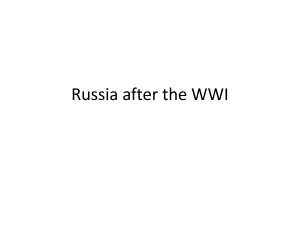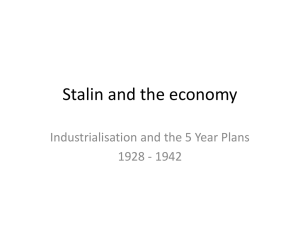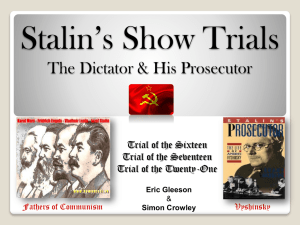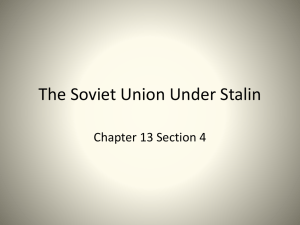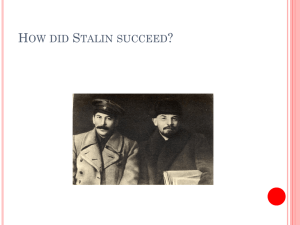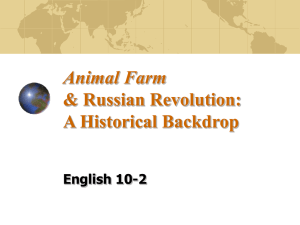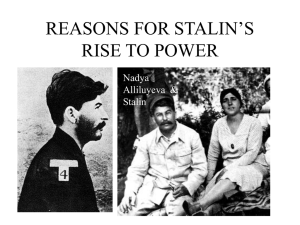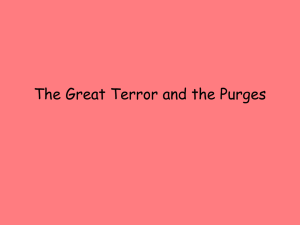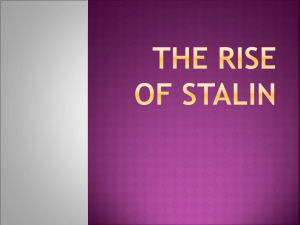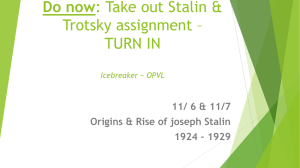Stalin`s Russia
advertisement
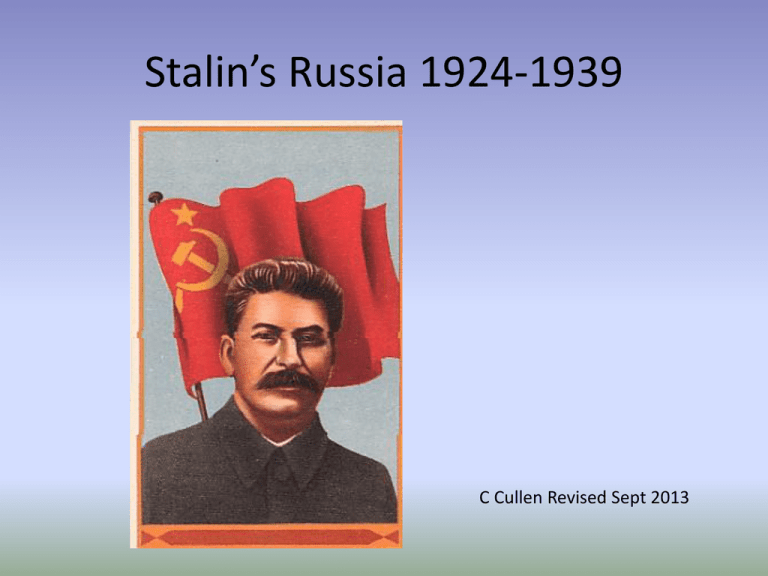
Stalin’s Russia 1924-1939 C Cullen Revised Sept 2013 After Lenin’s death in 1924, a leadership power struggle ensued. There were two main candidates to succeed Lenin: Josef Stalin and Leon Trotsky. Lenin had stated in his will that he preferred Trotsky, as Stalin was too brutal and could not be trusted with power. However, the contents of the will were not made public, so most people did not know about Lenin’s wishes. Trotsky was a Jewish intellectual and a member of the middle class. He was a Civil War hero and very well respected by members of the Red Army. Trotsky supported the idea of a communist world revolution led by the Bolsheviks. Stalin came from a poor lower-class family in Russia. He had played only a minor role in the Russian Civil War but had used his position as Communist Party secretary to Build a strong power base by appointing supporters to key positions. Stalin didn’t support a world communist revolution (at least not at that point in time) and instead envisioned a policy of “Socialism in One Country.” Stalin, Zinoviev, and Kamenev Stalin was able to win the leadership of the Communist Party with the support of three other leading Communists (Kamenev, Zinoviev, and Bukharin). Soon after taking power, he expelled Trotsky from the Party and later exiled him from the country. Eventually Trotsky was killed in Mexico by a KGB agent (with an ice pick as he slept) on Stalin’s orders. Stalin’s first goal was to get the USSR (Soviet Union) to industrialize rapidly in order to catch up to other nations and reduce the risk of invasion by a foreign power. He set up a series of Five Year Plans that would help create a strong industrial and agricultural base and help contribute to the creation of a strong military force. The First Five Year Plan (1928-33) focused on heavy industry, such as coal, iron ore, and steel and aimed to increase Russia’s industrial output by 250%. Private factories that had been created under the NEP were closed or nationalized. The First Five Year plan was very successful as organizers used a combination of incentives and harsh penalties to try to increase production. Stalin enacted a major propaganda campaign to promote the new Five Year Plan. This poster says that a new electricity plant is being constructed to benefit the USSR. The Second Five Year Plan (1933-37) continued to focus on industrial output, but also was intended to produce more consumer goods and better housing. However, as military tensions rose in Europe, the emphasis shifted to the production of armaments. The Third Year Plan (1937-42) was designed to produce consumer goods such as household items, bicycles and radios, but this program came to an abrupt halt in 1941 when Germany invaded the Soviet Union during World War 2. Results of Stalin’s Five Year Plans a. By 1940, the USSR had risen to #2 in the world for industrial power b. Urban population rose significantly as people moved to the cities to work. This led to some social issues such as lack of housing, shortages of goods, and crime. c. Although wages and working conditions were still not ideal, the standard of living did rise for many industrial / factory workers and the Soviets offered benefits such as health and education benefits for factory workers and their families. d. A number of huge projects were undertaken, but many involved the use of slave labourers. Agriculture is developing slowly, comrades. This is because we have about 25 million individually owned farms. They are the most primitive and undeveloped form of economy We must do our utmost to develop large farms and to convert them into grain factories for the country organised on a modem scientific basis.“ Josef Stalin 1928 By the late 1920’s most Russian peasants owned their land. The more prosperous farmers were known as the kulak class, and this was the group Stalin resented and wanted to see destroyed. He had earlier cancelled Lenin’s New Economic Policy, as he felt it did not follow communist principles. Stalin brought in the policy of collectivization in 1929, which was intended to abandon all private ownership of land and create huge state-owned farms that would be much more efficient. With the rapid industrialization, there were shortages of workers and food in the large cities, and collectivization would allow some of the peasant farmers to move to the cities to help solve the labour shortage. As well, collectivization fit into the communist philosophy as it promoted a classless society. Small farms were amalgamated into large collective farms, and each farm was allotted a tractor, seeds, and various tools. The peasants either received a small wage for their labour or were permitted a small plot of land to grow enough food for their families. Once again, propaganda was used to try to convince the Soviet citizens about the importance of the new agricultural policies. Wealthy Russian kulaks Many of the Russian farmers were opposed to collectivisation, and the kulaks were especially resistant, as they resented turning over their profitable farms to the government . Millions of defiant kulaks destroyed their crops and killed and ate their livestock rather than turn them over to communist officials. Up to two million kulaks were deported to the gulags in Siberia and other remote parts of the country to work as slave labourers. Russia’s Agricultural Output Before and After Collectivisation Grain 1928 = 73.3 million tons 1934 = 67.6 million tons Cattle 1929 = 70.5 million 1934 = 42.4 million Pigs 1928 = 26 million 1934 = 22.6 million Sheep and goats 1928 = 146.7 million 1934 = 51.9 million Early results of collectivization showed major decreases in agricultural production, and it took until the mid-late 1930’s for the crop and livestock numbers to fully recover. In the early 1930’s, the Ukraine region, known as the bread basket of Russia, suffered a devastating famine. There was a poor harvest due both to the weather and to kulak protests over collectivization. Despite the low yield, farmers were forced to hand over the little grain that was produced in order to meet their quotas. Millions of Ukrainians died during this time period. Kirov’s death march As Stalin became increasingly paranoid about possible traitors in the party and threats to his leadership, he enacted a series of purges, where people were killed or deported to the gulags for being traitors to the country. In 1934, Kirov, a very popular Communist Party member was assassinated (some historians think on Stalin’s orders) and Stalin used this event to justify the arrests of hundreds of thousands of people. Many were sent to gulags or executed, included a number of high ranking Communist Party officials. His former allies, Kamenev, Zinoviev, and Bukharin were all defendants in high-profile show trials, and all were found guilty and executed. Despite the fact that Stalin was a Georgian, he didn’t have much sympathy for the feelings of many of the different ethnic groups within the USSR and wanted to suppress any nationalism within the 11 republics of the country. For this reason, he brought in the policy of Russification, where Russian would be compulsory in schools, top jobs would be reserved for Russians and the glory of the Motherland would be emphasized at every opportunity. A 1963 Soviet stamp honouring Tukachevsky In 1937, as part of the Great Purge, Stalin targeted the Red Army, and executed 2/3 of the top-ranking officers, including Marshall Tukhachevsky, Commmander-in-Chief of the Red Army. This action greatly weakened the leadership and organization of the military and left the USSR poorly prepared for war. In 1939, Stalin and Hitler signed the non-aggression pact, where they agreed that Germany and the Soviet Union would not attack one another. They also secretly agreed to divide Poland between them and that the USSR could take over the Baltic states of Estonia, Latvia, and Lithuania.
